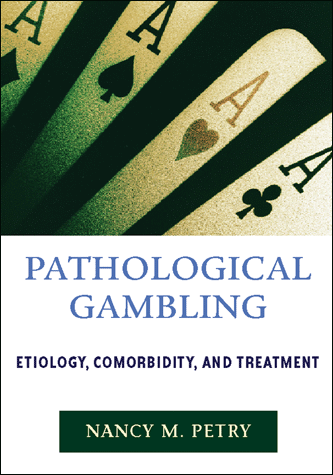A. Persistent and recurrent problematic gambling behavior leading to clinically significant impairment or distress, as indicated by the individual exhibiting four (or more) of the following in a 12month period: a. Pathological gambling disorder is distinguished from social gambling, in which the person is typically socializing with friends, gambling for a limited period of time, and gambling with a limited sum of money that they can afford to lose.
Brief Biosocial Gambling Screen (BBGS)
The Brief Biosocial Gambling Screen (BBGS) is a 3-item survey designed to help people decide on their own whether to seek a formal evaluation of their gambling behavior. The BBGS is based on the American Psychiatric Association’s Diagnostic and Statistical Manual of Mental Disorders (DSM-IV) criteria for pathological gambling.
DSM-5 Gambling Disorder Criteria
Pathological Gambling Gambling, or the practice of betting and thus risking the loss of one’s money, is considered an extremely risky pastime. People are often cautioned about the lure of casinos before making trips to resort towns such as Las Vegas and Atlantic City because it is easy to lose a small fortune on little vacations. Compulsive gambling, or pathological gambling as most psychiatrists prefer to call it, is an inability to stop gambling even when one recognizes that gambling is causing serious financial, family, work, or other problems. Compulsive gambling parallels alcohol and drug addiction in many ways.
The American Psychiatric Association provides guidelines used for gambling disorders in the Diagnostic and Statistical Manual of Mental Disorders, Fifth Edition (DSM-5). For more information on the DSM-5, please visit http://www.dsm5.org/.

NORC Diagnostic Screen for Gambling Problems-Self Administered (NODS-SA)

The NODS-SA is self-assessment version of the NODS (the NORC Diagnostic Screen for Gambling Disorders). It was designed to assist individuals in evaluating whether to modify or seek help for their gambling behavior. The NODS is based on the APA’s DSM-IV criteria for pathological gambling.
Please answer the following 10 yes/no questions honestly:
*REMINDER: this self-assessment will help you figure out if there is a problem, but only a professional can diagnose if it is a gambling problem, a different problem, or both.
If you answered yes to one or more of the above questions, you should seek help.
Pathological Gambling: Etiology, Comorbidity, and Treatment examines the prevalence and consequences of problem gambling as well as approaches to treatment. In this comprehensive book, Petry clarifies the current understanding of gambling as a disorder, including its levels of intensity; possible origins in biological, neurological, developmental, and environmental spheres; and special issues surrounding populations that seem to be more susceptible to problem gambling, including youth, ethnic minorities, and those with comorbid affective disorders such as depression.
The author reviews treatments commonly used for pathological gambling as well as nonprofessionally guided interventions such as Gamblers Anonymous. Petry then presents her own brief cognitive-behavioral approach, whose success is empirically proven in the largest known study of psychosocial treatments of problem gamblers.
This book represents a review of everything currently known about problem gambling as well as promising treatment approaches, making it an invaluable, comprehensive resource for both therapists and researchers in the field of pathological gambling.
Acknowledgments
I. Foundations for Understanding
What Causes Compulsive Gambling
- Introduction
- Terminology, Prevalence Rates, and Types of Gambling
- Assessment
II. Etiology
Pathological Gambling Etiology Comorbidity And Treatment
- Demographic Correlates
- Comorbidity of Disordered Gambling and Other Psychiatric Disorders
- Neurobiology and Genetics
III. Research on Interventions
- Pharmacotherapies
- Recovery Without Professional Intervention
- Therapy for Families and Significant Others
- Psychoanalytic and Psychodynamic Treatments
- Early Behavioral Treatments
- Cognitive Biases and Cognitive Therapy
IV. A Treatment Model
- Cognitive–Behavioral Therapy
- Brief and Motivational Interventions
Pokermania. V. Conclusions
- Prevention: Focus on Gambling in Youth and Young Adults
- Conclusions
Appendix A
Appendix B
Appendix C
Appendix D
References
Author Index Doubledown casino free coins facebook.
Subject Index
About the Author
Nancy M. Petry earned a BA in 1990 from Randolph-Macon Woman's College and a PhD from Harvard University in 1994. In 1996, she joined the faculty of the University of Connecticut Health Center, where she is a professor of psychiatry.
She conducts research on the treatment of addictive disorders, ranging from substance use disorders to pathological gambling, and has published more than 80 peer-reviewed articles. Her work is funded by the National Institute on Drug Abuse, the National Institute of Mental Health, and the National Institute on Alcohol Abuse and Alcoholism.
Pathological Gambling Disorder
Dr. Petry serves as a consultant and advisor for the National Institute of Health, and she is on the editorial boards of six academic journals. She received the APA Distinguished Scientific Award for Early Career Contribution to Psychology in 2003.
Pathological Gambling

Choice Outstanding Title!
Symptoms Of Pathological Gambling
Anyone with a serious interest in gambling will want this book in their personal library. Now and for the future, this work should remain an indispensable piece of scholarship for those working as researchers and practitioners in this field. Essential.
—CHOICE Magazine Archer free slot app.